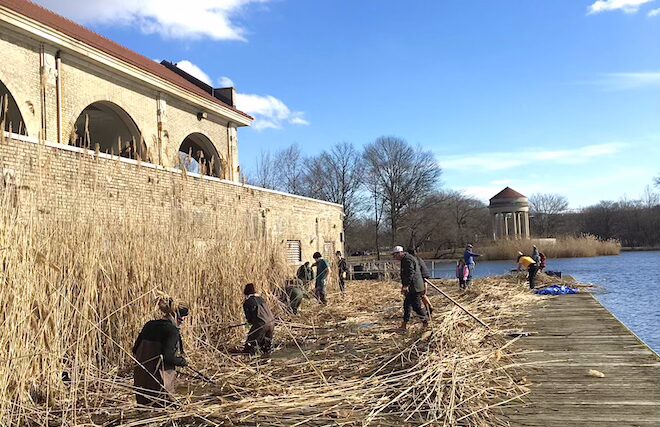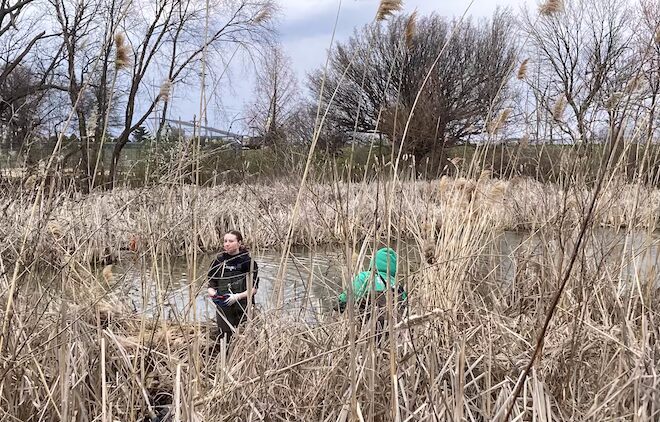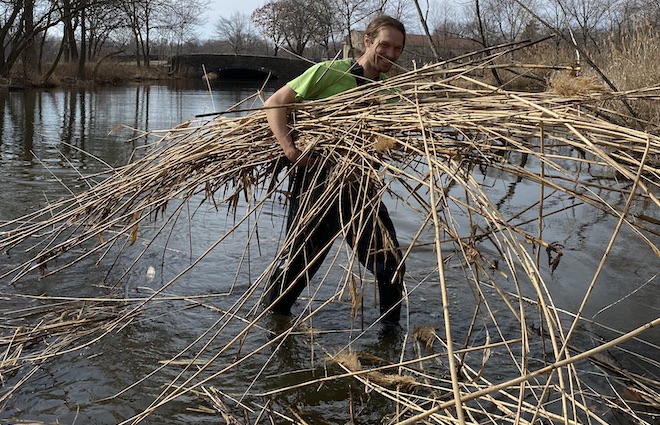On a gray January day in 2024 — a damp, bone-cold afternoon that made me wonder why I’d come — I joined a drawn out geology tour at South Philly’s FDR Park. The problem wasn’t just the weather, it was the topic. At the start, the guide explained that beneath the surface of FDR was mostly a landfill / infill mix and groundwater. And that was it, no further elaboration.
Listen to the audio version of the story here:
But then, at the tail end of the plodding walk, there was a scratch of light in an overheard conversation. I sidled up to a spirited exchange between Mildred Pitts of We Walk PHL and Cheryl Brubaker — one of only two co-residents of the park, who, along with her husband Merle, has been a caretaker of the 18th-century Bellaire Manor at FDR for 38 years.
But they weren’t talking about geology. They were talking about a woman named Tara Anastasi. What they said — and how they said it — was the first sign that, in this place, seeing the surface wasn’t the same as knowing what was there.
Later I learned Anastasi worked as the park’s volunteer coordinator — funded by the Friends of FDR Park — and as landcare manager, a position through the City’s Department of Parks & Recreation. But now Brubaker joked that she wanted to make a T-shirt: Tara Can Do It.
As I came to understand, the exchange spoke not just about Anastasi but also about the well-synced working dynamic between her and FDR’s first park director Justin DiBerardinis — a collaboration that seemed almost instinctive. (DiBerardinis left FDR in 2024 to become executive director of the Tookany / Tacony-Frankford Watershed Partnership.)
Later, in a text exchange, Brubaker explained that DiBerardinis would lay out what needed to be done, and Anastasi’s response was always the same: I can do that! DiBerardinis had the big-picture job; Anastasi had the application and on-the-ground know-how. As Cheryl put it, “What I said was, we need to encourage Justin as he works on the big-picture plans — and then just MAKE WAY FOR TARA!!”

“Yes, sure, why not?”
Anastasi started at FDR during Covid, when the 348-acre urban green space provided a safe haven and a sense of belonging to a wide-ranging intergenerational cohort of South Philadelphia residents. She recalls those first early days, which were all about building relationships and finding ways to put people’s energy to work. “So many people cared about the park,” she says. “And my job as volunteer coordinator was really relationship creator and leverager.”
When people would ask how they could help, she’d tell them, “I have the best job because every day I get to say yes to people.” She says, “Most places, when you offer to help, they say, ‘Oh, you can pull weeds or pick up trash.’ And if you can’t do that, you can’t help. But here, people asked to do the wildest things, and I’d think, Yes, sure, why not?” The work was endless.
They took on projects big and small — furloughed arborists helped remove invasive trees around the lake, and other skilled volunteers tackled tasks that might have raised eyebrows in a different moment. It’s one of the paradoxes of public life: We regulate in hindsight and innovate in real time, navigating between past lessons and present pressures. The question was whether they were playing it too safe — or not safe enough. The stakes were high either way. As Anastasi put it, “People just wanted to give back — they had been stuck at home for Covid.”
In just six months, the area around the park’s clubhouse was completely transformed.
“I have the best job because every day I get to say yes to people.” — Tara Anastasi
Now, those relationships form the foundation of an extensive volunteer network at the park. Whenever something needs to get done, Anastasi says, “I just start calling: I know their names, their dogs’ names, their kids’ names. It’s like this is my home, and I’m hosting people as they come into the park.”
At first, Anastasi was just collecting names and emails — tapping them into her phone or scribbling them on the backs of envelopes. Then she moved everything into an Excel spreadsheet, and the list grew. “We have active people,” she says. Soon she was sending regular updates about everything they needed, from tools, spare parts and patches for the weary four-seat John Deere cart, called “The Gator,” to keep it rolling around the grounds.
In the beginning, she also made sure to offer at-home projects, knowing that not everyone could — or wanted to — come out during the pandemic but still wanted to contribute. That’s how the signs got painted and the many birdhouses built. That’s how the kids’ nature area took shape. Eventually, the sandbox, the mural on the barn — all of it. “People just wanted to contribute to this new space,” she says, “because it was from scratch, and it was helping the community.”
How can people and nature coexist?
Growing up in Brooklyn, Anastasi had always loved plants and animals. That was the starting point. “I thought I wanted to do research, maybe conservation,” she said. She studied environmental biology, imagining a future spent in the field. But then came a study abroad program in Mexico, where she worked with sea turtles and saw the limits of that approach.
“I remember thinking —I could help these turtles, or I could understand why they’re being eaten,” she says. “People were living in poverty; they needed food.” The problem wasn’t just ecological. It was human.
That realization reshaped everything. She turned to sociology, trying to understand why people make the choices they do and how those choices impact nature. “People and nature have to coexist somehow,” she says. That became the new framework.
Anastasi set out to study biodiversity in the fields and at sea, but her search led her back to people. She followed that thread — studying how food systems shaped health, communities, and the environment itself. “A lot of people were dying, especially people of color, and it was all connected to food,” she says. That led her to grad school for agriculture and nutrition, specifically urban agriculture — expertise she now applies at FDR, where she carries that sense of relationship — the interplay of people, systems, and the natural world — to cultivate a space where each can support the other.

Clearing the way, together
Through a loose but meaningful steward structure that provided open yet workable guidelines, Anastasi coordinated the efforts of a growing corps of over 500 volunteers. But her greatest collective accomplishment may have been clearing the dense stands of the invasive reeds — anywhere from 12 to 20 feet high — that had nearly swallowed FDR’s two lakes and its lagoon. Their pale tan stalks, crowned with feathery seed heads, formed thickets that swayed in unison with the wind.
Anastasi recalls that when she first arrived at FDR in 2019, Edgewood Lake was nearly invisible. “When I got here, you actually didn’t even know there was a lake there unless you were [directly] at the boathouse on the dock because of how tall those phragmites were,” she says.
Clearing them was no small feat. To understand the scale of their work, consider the three main water bodies in the park:
- Edgewood Lake spans 2,919 feet — just over half a mile, roughly the length of eight football fields placed end to end.
- The lagoon’s circumference is 2,247 feet — just under half a mile, or about the length of six football fields. While some of it is accessible near the Anna C. Verna Playground and visible from the Welcome Center, most remains critical habitat for nesting birds, waterfowl, and turtles.
- Meadow Lake has a circumference of 1,689 feet — about a third of a mile, or roughly five football fields long end to end.
For years, dense stands of phragmites choked these lakes. Meadow Lake still remains infested on the east side of the park near Broad Street. The labor-intensive challenge wasn’t just clearing the areas around the lakes — these invasive reeds had extended 20 to 30 feet outward into the water.
Anastasi remembers tagging along on a small group tour of the park when DiBerardinis pointed to the phragmites and said, “This winter, we are going to clear all of these phragmites out of this lake.”
No staff. No money. No equipment. Everything was donated — time, tools, whatever they could get. Anastasi heard DiBerardinis’ big plans and thought, Oh, that’s what we’re doing this winter.
Moored on their maiden voyage
Crowding out everything else in its path, the phragmites dominated the landscape.
The first few times out were humbling. The moment they stepped in, the stench hit — deep and sour, filling the nose and settling in the back of the throat. On this first day out, it rose from the anaerobic muck as Anastasi and three team members waded into the phragmites, only a few steps from the water’s edge. The reeds towered over them, but beneath them, the thick mud was treacherous.
Anastasi took a step and felt her boot vanish. She shifted her weight, and the other leg sank too. A few feet away, one of the volunteers let out a curse. Another stood silent, her face frozen, blank, looking inward, afraid. A third was already in past his knees. This wasn’t the kind of heavy mud you could muscle your way out of. Each tug only pulled them in deeper.
Anastasi was as stuck as the rest, but they looked to her for guidance. She said, in effect, Don’t fight it — keep still, keep light.
The interns and volunteers might not have realized, at first, what kind of job they were signing up for. Cutting back phragmites seemed straightforward enough. But Anastasi was starting to grasp the enormity of the task: The reeds had no intention of yielding, and the heavy mud-mix was just as eager to pull her under. Still, she was in charge of rallying the team, which also meant keeping up her own spirits. They needed to believe the work mattered, even when it felt, and was, endless.
“You could see the water. You could see the ducks. It was like the curtain kept opening and opening, and suddenly, this vista appeared.” — Tara Anastasi
So she gave it a name — Anastasi began calling it “the phrag.” She’d say, We’re phragging today, or We’re going out to phrag!
Day by day, week by week, season by season, they kept at it — cutting, clearing, making space. What started with a handful of interns and borrowed tools grew into a steady, relentless effort, with a rotating crew of die-hard volunteers who kept showing up. Bit by stinking bit, the dense wall of phragmites gave way — until one day, almost without realizing it, they could see the lake again.
Fast forward, “We just cut it all down. The entire lake” she said. “You could see the water. You could see the ducks. You could see it all without just having to stand in this one spot on the dock. It was like the curtain kept opening and opening, and suddenly,” her eyes brightening, “this vista appeared.”
People stopped in their tracks. Stunned by what had been hidden in plain sight. Visitors were grateful. Someone told her, “Not only was there a lake here [now], but I’ve been coming here for 30 years, and I’ve never seen this.”
Anastasi laughed and beamed, “You’re welcome.”
“The phragmites spread so vigorously,” she said. “I think because they’re everywhere, people just assumed they were supposed to be here.”
But now, with the lake visible, something else came into focus.
Decades’ worth of trash.
It had been sucked deep into the waterlogged mire, tangled in reeds, buried in the muck. On volunteer days, they pulled it out, piece by mucky piece — bottles, tires, a well-preserved hockey stick, a trash bag full of bog-strewn sneakers and filthy baseball cleats — all lost, forgotten, tossed away.
“I had people coming up to me — fishermen — who said, ‘I have waders. Can I come in and help you?’”
Anastasi nodded, yes.

One lake down …
That first spring, with the first lake finally cleared, the first signs of renewal were cause for celebration. Then came one last, unexpected turn — a surprise that felt less like a job well done than a minor ecological miracle. The water’s edge came back to life. Seedbeds, submerged for decades, surfaced. Where dense stands of phragmites had turned the shoreline into a biological dead zone, native plants began to take hold — cattails, purple-tipped pickerelweed — long buried but waiting.
It took multiple iterations and thousands more staff and volunteer hours, but the efforts to reclaim the lake reshaped its contours, opening space for both people and wildlife. The results were striking. The newly opened vistas restored a central feature of the Olmsted Brothers’ original vision — not only framing the water as a focal point within a living landscape, but also restoring its role as a gathering place.
It’s a reminder, as the Fairmount Park Conservancy has embarked on a $250 million renovation of FDR, of what remains possible, offering itself again and again across generations — and now, as a gift. Turtles basked on newly exposed logs, great blue herons stalked the shallows, and water quality improved. Fish, once struggling in the oxygen-depleted waters, began to rebound. The lake’s ecosystem was recovering.
The volunteers, too, remained — bound together by Anastasi’s stewardship and the work they had done. Two who met while cutting phragmites in Meadow Lake started dating and later got engaged. Anastasi stood tall as she said she had recently received a save-the-date card. She smiled. The vistas had come back. So had the people and the lake.
Correction: A previous version of this post misnamed the Fairmount Park Conservancy. The Citizen regrets this error.
Thomas Devaney is a staff writer at Drexel University’s Lindy Institute for Urban Innovation. A Pew Fellow in the Arts, he is the author of Getting to Philadelphia and the writer and co-director of the film Bicentennial City, which explores the legacy of Philadelphia’s 1976 bicentennial celebration. His graduate thesis on FDR Park explores the role of urban parks as spaces for both people and nature.
![]() MORE CITIZENS OF THE WEEK
MORE CITIZENS OF THE WEEK




